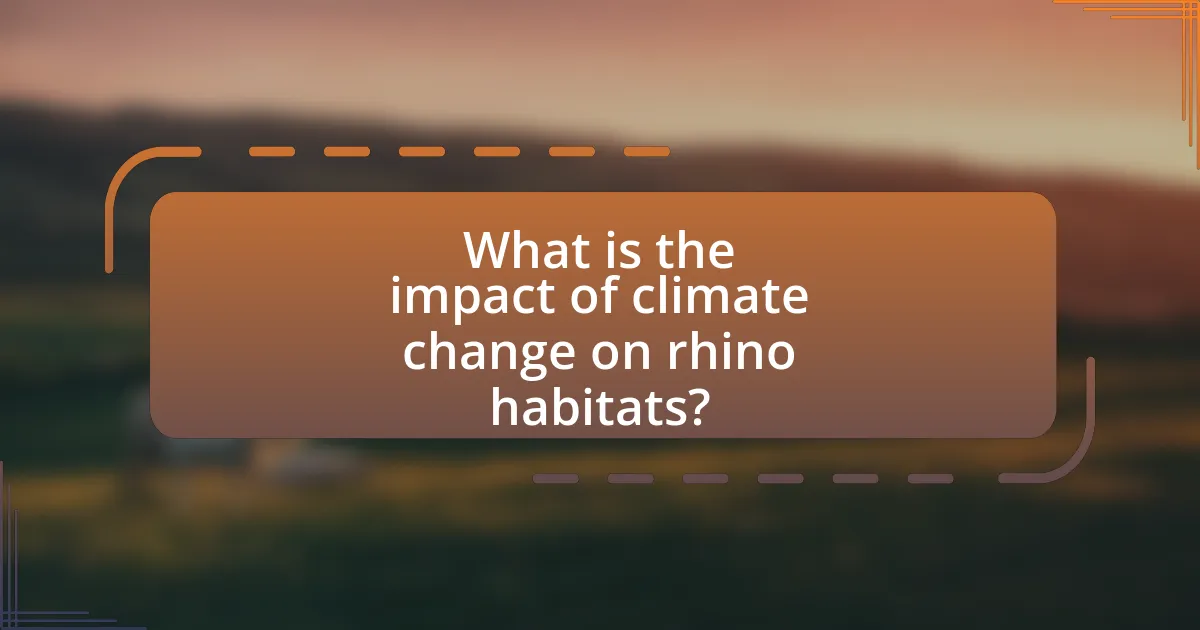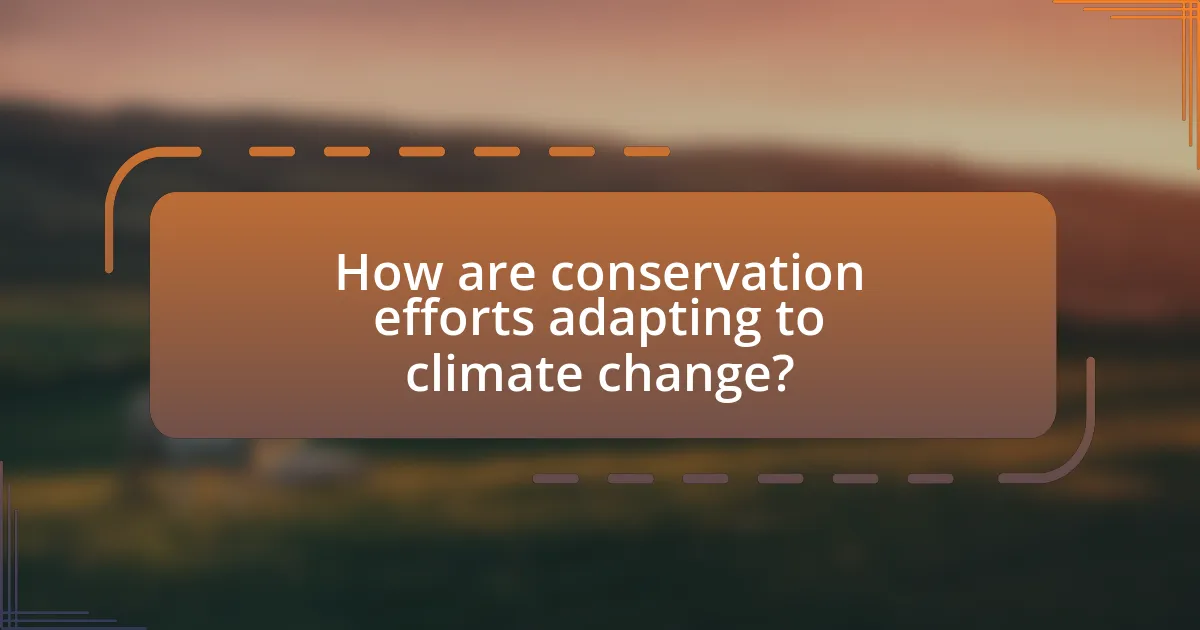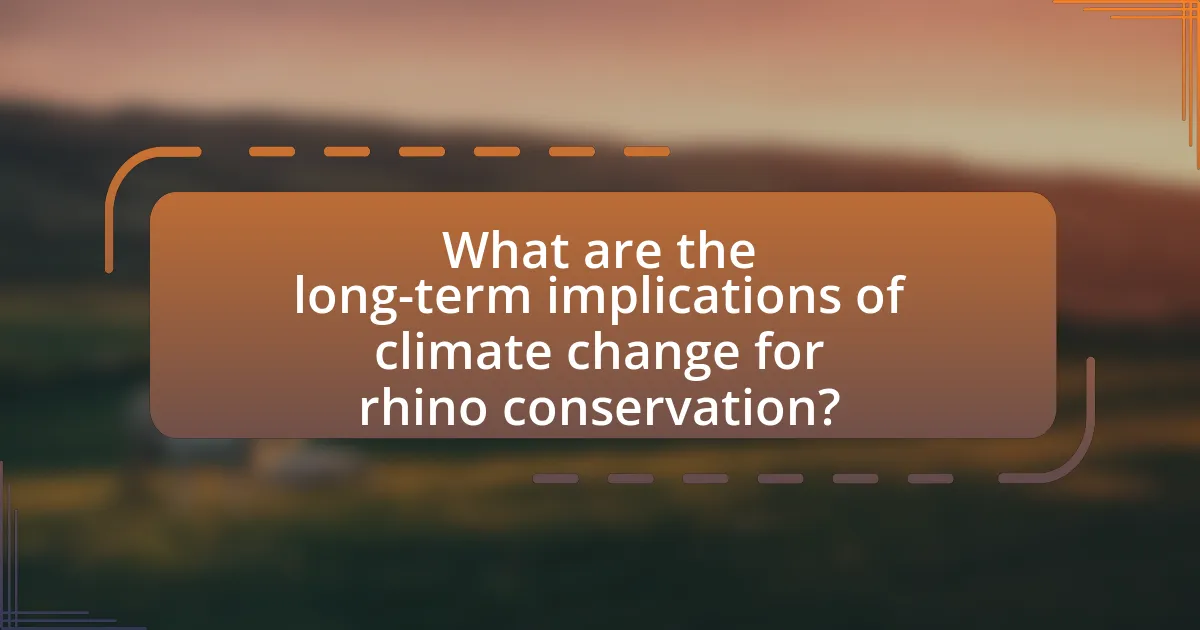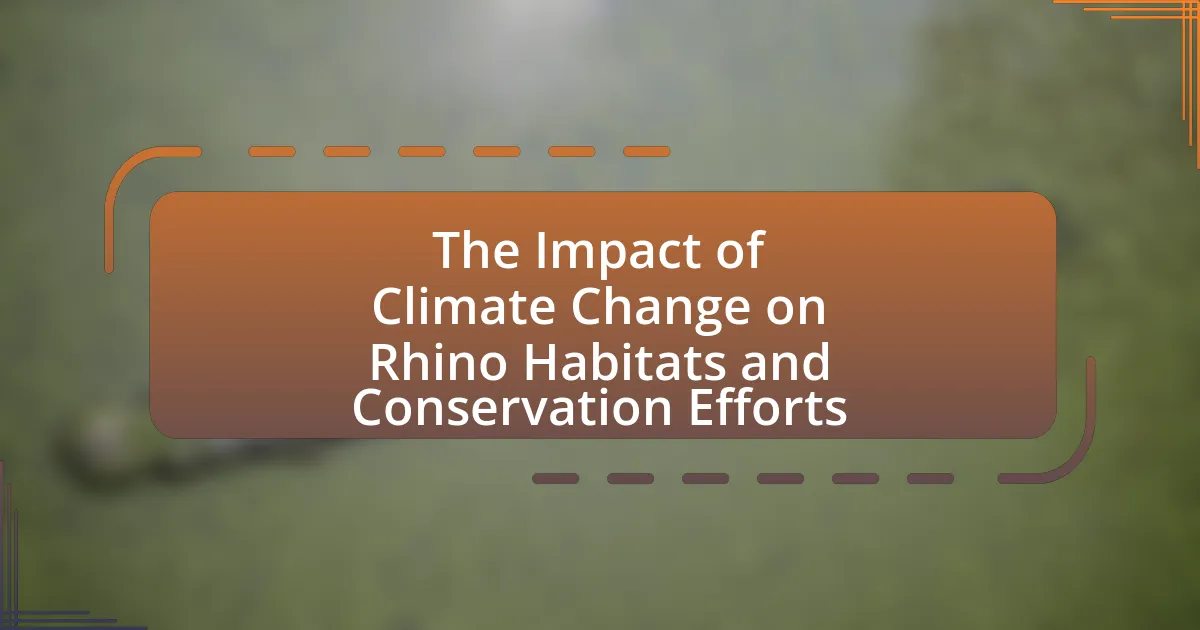The article examines the impact of climate change on rhino habitats and the subsequent conservation efforts aimed at mitigating these effects. It highlights how rising temperatures and altered precipitation patterns lead to habitat degradation, reduced food and water availability, and increased vulnerability to poaching for rhinos. The discussion includes specific changes in ecosystems, the consequences of habitat loss and fragmentation, and the strategies being implemented to protect rhino populations. Additionally, it addresses the challenges conservation organizations face in securing funding and the importance of partnerships and sustainable practices in enhancing conservation efforts. The article emphasizes the urgent need for adaptive management strategies to ensure the survival of rhinos in a changing climate.

What is the impact of climate change on rhino habitats?
Climate change significantly alters rhino habitats by affecting vegetation patterns, water availability, and overall ecosystem stability. Rising temperatures and changing precipitation patterns can lead to habitat degradation, reducing the availability of food and water sources essential for rhinos. For instance, studies indicate that increased drought frequency can diminish grasslands, which are crucial for species like the white rhino. Additionally, habitat fragmentation due to climate-induced changes can isolate rhino populations, making them more vulnerable to poaching and reducing genetic diversity. These impacts underscore the urgent need for conservation strategies that address climate change effects on rhino habitats.
How does climate change affect the ecosystems where rhinos live?
Climate change significantly disrupts the ecosystems where rhinos live by altering their habitats and food sources. Increased temperatures and changing precipitation patterns can lead to habitat degradation, reducing the availability of grasslands and forests that rhinos depend on for sustenance. For instance, studies indicate that rising temperatures can cause shifts in vegetation types, which may not support the nutritional needs of rhinos, ultimately affecting their survival and reproduction rates. Additionally, climate change can exacerbate drought conditions, leading to water scarcity, which is critical for rhinos and other wildlife. These changes threaten the delicate balance of the ecosystems, making it increasingly difficult for rhinos to thrive in their natural habitats.
What specific changes in temperature and precipitation patterns are observed?
Specific changes in temperature patterns include an increase in average global temperatures, with a rise of approximately 1.2 degrees Celsius since the late 19th century. This warming trend affects rhino habitats by altering vegetation growth and water availability. Precipitation patterns are also changing, with some regions experiencing increased rainfall while others face prolonged droughts, impacting the ecosystems that support rhinos. For instance, the Intergovernmental Panel on Climate Change (IPCC) reports that many areas in southern Africa are projected to see a decrease in rainfall, which can lead to habitat degradation and reduced food sources for rhinos.
How do these changes influence the availability of food and water for rhinos?
Climate change significantly reduces the availability of food and water for rhinos. Altered precipitation patterns and increased temperatures lead to droughts, which diminish water sources and affect the growth of vegetation that rhinos rely on for sustenance. For instance, studies indicate that prolonged dry spells can reduce grassland productivity by up to 50%, directly impacting the food supply for herbivores like rhinos. Additionally, habitat loss due to climate-induced changes further exacerbates the scarcity of both food and water, making it increasingly difficult for rhinos to thrive in their natural environments.
What are the direct consequences of habitat loss for rhinos?
Habitat loss for rhinos leads to a significant decline in their population and genetic diversity. As their natural environments are destroyed, rhinos face increased competition for limited resources, such as food and water, which can result in malnutrition and lower reproductive rates. Furthermore, fragmented habitats make it difficult for rhinos to find mates, leading to inbreeding and reduced genetic diversity, which compromises their resilience to diseases and environmental changes. According to the International Union for Conservation of Nature (IUCN), habitat loss is one of the primary threats to rhino survival, contributing to the decline of several species, including the critically endangered Javan and Sumatran rhinos.
How does habitat fragmentation affect rhino populations?
Habitat fragmentation negatively impacts rhino populations by isolating them into smaller, disconnected areas, which reduces genetic diversity and increases vulnerability to extinction. When habitats are fragmented, rhinos face challenges in finding mates, leading to inbreeding and a decline in population health. Studies indicate that fragmented landscapes can decrease rhino movement and access to resources, ultimately resulting in lower survival rates. For instance, research published in the journal “Biological Conservation” highlights that fragmented habitats can lead to a 30% reduction in rhino population growth rates due to these factors.
What role does habitat degradation play in rhino survival?
Habitat degradation significantly threatens rhino survival by reducing the availability of food and shelter, which are essential for their health and reproduction. As habitats become fragmented due to human activities like agriculture and urban development, rhinos face increased competition for resources and are more vulnerable to poaching. Studies indicate that habitat loss has contributed to a decline in rhino populations, with some species, such as the Javan rhino, facing critical endangerment due to limited habitat availability. Furthermore, climate change exacerbates habitat degradation by altering ecosystems, leading to further loss of suitable environments for rhinos.

How are conservation efforts adapting to climate change?
Conservation efforts are adapting to climate change by implementing strategies that enhance habitat resilience and species protection. These strategies include the establishment of climate-smart protected areas, which are designed to accommodate shifting species distributions and changing environmental conditions. For instance, organizations like the World Wildlife Fund have developed adaptive management plans that incorporate climate projections to guide conservation actions. Additionally, conservationists are utilizing technology, such as remote sensing and modeling, to monitor habitat changes and assess the effectiveness of interventions. This approach is supported by research indicating that proactive adaptation measures can significantly improve the survival rates of vulnerable species, including rhinos, in the face of climate change.
What strategies are being implemented to protect rhino habitats?
Strategies being implemented to protect rhino habitats include habitat restoration, anti-poaching measures, and community engagement initiatives. Habitat restoration involves reforestation and the rehabilitation of degraded areas to ensure suitable living conditions for rhinos. Anti-poaching measures, such as increased surveillance and law enforcement, aim to reduce illegal hunting, which threatens rhino populations and their habitats. Community engagement initiatives focus on involving local populations in conservation efforts, providing education about the importance of rhinos, and promoting sustainable land-use practices. These strategies are supported by organizations like the World Wildlife Fund, which reports that effective habitat protection can lead to increased rhino populations and healthier ecosystems.
How do conservationists prioritize areas for protection in a changing climate?
Conservationists prioritize areas for protection in a changing climate by assessing ecological resilience, species vulnerability, and habitat connectivity. They utilize climate models to predict future conditions and identify regions that can sustain biodiversity despite climate shifts. For instance, studies indicate that areas with high ecological resilience, such as those with diverse habitats and species, are prioritized because they are more likely to adapt to changing conditions. Additionally, conservationists consider the potential for habitat corridors that facilitate species movement, which is crucial for maintaining genetic diversity and ecosystem health. This strategic approach is supported by research from the Intergovernmental Panel on Climate Change, which emphasizes the importance of adaptive management in conservation planning.
What innovative approaches are being used to restore degraded habitats?
Innovative approaches to restore degraded habitats include the use of ecological restoration techniques, such as rewilding, assisted migration, and the implementation of agroforestry systems. Rewilding involves reintroducing native species to restore ecological balance, while assisted migration helps species adapt to changing climates by relocating them to more suitable habitats. Agroforestry integrates trees and shrubs into agricultural landscapes, enhancing biodiversity and soil health. These methods have been supported by studies showing that rewilding can increase species diversity by up to 50% in certain ecosystems, and agroforestry can improve carbon sequestration by 30% compared to conventional farming practices.
How do climate change impacts influence conservation funding and resources?
Climate change impacts significantly influence conservation funding and resources by redirecting financial priorities towards urgent adaptation and mitigation strategies. As ecosystems face increased threats from climate-related events, such as habitat loss and species extinction, funding agencies prioritize projects that address these immediate challenges. For instance, a report by the Intergovernmental Panel on Climate Change (IPCC) highlights that climate change could lead to a 30% increase in funding needs for biodiversity conservation by 2030, as habitats become more vulnerable. Consequently, conservation organizations must compete for limited resources, often leading to a reallocation of funds from traditional conservation efforts to those specifically aimed at climate resilience.
What challenges do conservation organizations face in securing funding?
Conservation organizations face significant challenges in securing funding, primarily due to competition for limited financial resources. Many organizations compete for the same pool of donors, which can lead to funding shortages. Additionally, economic downturns often result in reduced donations from individuals and corporations, further straining financial support. According to a report by the World Wildlife Fund, 60% of conservation organizations reported a decline in funding during economic recessions, highlighting the vulnerability of these organizations to economic fluctuations. Furthermore, the complexity of conservation projects can deter potential funders who may prefer simpler, more immediate causes. These factors collectively hinder the ability of conservation organizations to secure necessary funding for their efforts, particularly in the context of addressing the impacts of climate change on rhino habitats.
How can partnerships enhance conservation efforts in the face of climate change?
Partnerships can enhance conservation efforts in the face of climate change by pooling resources, expertise, and data among various stakeholders, including governments, NGOs, and local communities. Collaborative initiatives, such as the African Rhino Conservation Plan, demonstrate how shared knowledge and coordinated actions can lead to more effective habitat protection and species management. For instance, partnerships can facilitate the implementation of adaptive management strategies that respond to changing environmental conditions, thereby increasing resilience against climate impacts. Additionally, joint funding efforts can support innovative conservation technologies, such as satellite monitoring systems, which provide real-time data on habitat changes and poaching activities, ultimately improving conservation outcomes for vulnerable species like rhinos.

What are the long-term implications of climate change for rhino conservation?
Climate change poses significant long-term implications for rhino conservation, primarily through habitat loss, altered ecosystems, and increased poaching risks. As temperatures rise and precipitation patterns shift, suitable habitats for rhinos may diminish, leading to reduced food availability and increased competition for resources. For instance, studies indicate that climate change could reduce the range of the white rhino by up to 50% by 2100, severely impacting their populations. Additionally, changing climates can exacerbate human-wildlife conflict, as rhinos may encroach on agricultural areas in search of food, leading to increased poaching as farmers retaliate. Furthermore, climate-induced stressors can weaken rhino health, making them more susceptible to diseases. These factors collectively threaten the viability of rhino populations and complicate conservation efforts, necessitating adaptive management strategies to mitigate these impacts.
How might future climate scenarios affect rhino populations?
Future climate scenarios may significantly reduce rhino populations due to habitat loss and altered ecosystems. As temperatures rise and precipitation patterns change, suitable habitats for rhinos may diminish, leading to decreased food availability and increased competition for resources. For instance, studies indicate that climate change could lead to a 30% reduction in suitable habitats for African rhinos by 2050, impacting their survival rates. Additionally, extreme weather events, such as droughts and floods, can further threaten rhino populations by disrupting breeding patterns and increasing mortality rates.
What predictions can be made about rhino extinction risks due to climate change?
Predictions indicate that rhino extinction risks will increase significantly due to climate change, primarily through habitat loss and altered ecosystems. As temperatures rise and precipitation patterns shift, suitable habitats for rhinos may diminish, leading to reduced food availability and increased competition for resources. For instance, studies project that by 2050, certain rhino habitats could shrink by up to 50% due to climate-related factors, exacerbating their vulnerability. Additionally, climate change can intensify poaching pressures as stressed ecosystems may lead to increased human-wildlife conflict, further threatening rhino populations.
How can adaptive management strategies mitigate these risks?
Adaptive management strategies can mitigate risks associated with climate change impacts on rhino habitats by allowing for flexible and iterative decision-making processes. These strategies enable conservationists to monitor environmental changes and adjust management practices in real-time, ensuring that interventions remain effective as conditions evolve. For instance, adaptive management has been successfully applied in various wildlife conservation efforts, where continuous feedback loops inform habitat restoration and protection measures, thereby enhancing resilience against climate variability. This approach is supported by studies indicating that adaptive management can lead to improved outcomes in biodiversity conservation, as it incorporates scientific data and stakeholder input to refine strategies over time.
What practical steps can individuals take to support rhino conservation?
Individuals can support rhino conservation by donating to reputable wildlife organizations that focus on rhino protection, such as the World Wildlife Fund or Save the Rhino. These organizations utilize funds for anti-poaching efforts, habitat preservation, and community education programs. Additionally, individuals can participate in or organize local awareness campaigns to educate others about the threats rhinos face, including habitat loss due to climate change. Supporting sustainable tourism initiatives that promote rhino conservation can also be effective, as responsible tourism generates revenue that can be reinvested into conservation efforts. Lastly, advocating for policies that protect wildlife and their habitats can influence government action and funding for conservation programs.
How can awareness and education contribute to rhino conservation efforts?
Awareness and education significantly enhance rhino conservation efforts by fostering understanding and support for protective measures. Educating communities about the ecological importance of rhinos and the threats they face, such as poaching and habitat loss, can lead to increased local engagement in conservation initiatives. For instance, programs that inform people about the role of rhinos in maintaining ecosystem balance can motivate them to participate in anti-poaching efforts and habitat restoration projects. Research indicates that communities involved in conservation education are more likely to adopt sustainable practices, as seen in various successful conservation programs across Africa, where local involvement has led to a reduction in poaching rates by up to 50%.
What role do sustainable practices play in protecting rhino habitats?
Sustainable practices are crucial in protecting rhino habitats by promoting biodiversity and reducing environmental degradation. These practices, such as responsible land use, conservation agriculture, and eco-friendly tourism, help maintain the ecological balance necessary for rhinos and their habitats. For instance, sustainable land management can prevent habitat loss due to agriculture and urbanization, which are significant threats to rhino populations. Additionally, sustainable tourism generates revenue that can be reinvested into conservation efforts, directly benefiting rhino habitats. Studies show that areas implementing sustainable practices experience a 30% increase in wildlife populations, highlighting their effectiveness in habitat protection.
